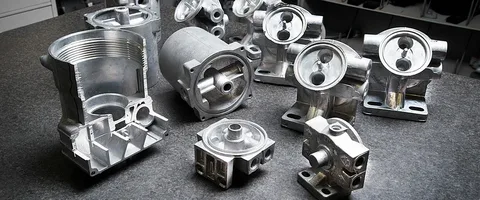Die casting has become one of the most efficient and reliable manufacturing methods for creating complex metal parts with precision. Whether you’re developing automotive components, electronic housings, or industrial machinery parts, selecting the right die casting materials plays a crucial role in the success of your project. The right material affects not only the performance and durability of the finished product but also the production cost, turnaround time, and post-processing requirements.
Given the wide variety of alloys and metals available for die casting, choosing the most appropriate one requires a thorough understanding of each material’s properties, advantages, and limitations. This article explores the key considerations in selecting die casting materials by examining their mechanical properties, corrosion resistance, cost-effectiveness, and compatibility with the intended application. By the end, you’ll have the knowledge needed to make an informed decision for your next die casting project.
Understanding the Role of Die Casting Materials in Manufacturing
The selection of die casting materials is fundamental to the success of any casting process because each material behaves differently under heat and pressure. When molten metal is injected into a mold, its ability to fill intricate shapes and maintain dimensional stability is determined by its composition. Materials with superior fluidity like zinc can capture fine details, while stronger metals like aluminum offer greater durability under mechanical stress. Understanding these inherent traits helps designers and engineers optimize both the casting process and the performance of the final part.
Furthermore, die casting materials influence several aspects of production such as mold life, cycle time, and required maintenance. Materials with higher melting points, like copper or magnesium alloys, typically lead to faster wear and tear on molds. Conversely, softer alloys like zinc can increase tooling lifespan. These factors directly impact manufacturing efficiency and overall project costs, making it imperative to carefully evaluate which die casting material suits your project’s specific demands.
Key Properties to Consider When Selecting Die Casting Materials
Mechanical properties such as tensile strength, hardness, and elongation are vital metrics to consider when choosing die casting materials. For example, if your project involves structural components or load-bearing parts, aluminum and magnesium alloys offer a good balance of strength and lightweight characteristics. On the other hand, if the component needs to resist wear or maintain tight tolerances under heat, zinc or copper-based alloys may be more suitable due to their dimensional stability and hardness.
Thermal and electrical conductivity are also essential properties, especially in applications involving heat dissipation or electronics. Copper and magnesium alloys are known for their excellent thermal conductivity, making them ideal for components like heat sinks and electronic casings. Additionally, thermal resistance must be considered in high-temperature applications to avoid warping or material degradation over time. Each die casting material has a unique profile of these properties, and the right selection depends on the specific operating environment of the part being manufactured.
Comparing Common Die Casting Materials and Their Applications
Aluminum alloys are among the most commonly used die casting materials due to their excellent strength-to-weight ratio, corrosion resistance, and affordability. They are ideal for industries such as automotive and aerospace, where weight reduction is critical without sacrificing structural integrity. Popular aluminum alloys like A380 or A383 offer good casting characteristics and are easily machined and anodized for further processing. However, aluminum’s high melting point can shorten tool life, which needs to be accounted for during planning.
Zinc alloys, on the other hand, are preferred for producing small, intricate components with tight tolerances. Their low melting points contribute to longer mold life and shorter cycle times, making them cost-effective for high-volume production. Common in consumer electronics, plumbing fixtures, and automotive interior parts, zinc die casting materials offer superior surface finish and dimensional precision. However, they are heavier than aluminum and not as heat-resistant, limiting their use in certain applications.
Cost vs. Performance: Striking the Right Balance
Balancing cost and performance is one of the most challenging aspects of selecting the best die casting materials for a project. While high-performance materials like copper or magnesium offer excellent mechanical and thermal properties, they are generally more expensive and harder to work with. Magnesium, for example, is lighter than aluminum and offers good machinability, but it requires a controlled environment due to its flammability during processing. Copper offers superior conductivity and strength but is less fluid, making it unsuitable for very intricate parts.
On the other hand, more economical options like zinc and standard aluminum alloys often provide the best trade-offs for many industrial applications. These materials are relatively easy to cast, support fast production cycles, and offer sufficient mechanical strength for non-critical parts. Choosing a die casting material based on performance alone may lead to budget overruns, while focusing solely on cost can compromise product quality. Therefore, finding a middle ground that satisfies both financial constraints and functional requirements is essential for project success.
Environmental and Post-Processing Considerations
Sustainability and environmental impact are becoming increasingly important factors in the selection of die casting materials. Recyclability, energy consumption during casting, and emissions are all evaluated as part of a material’s environmental footprint. Aluminum, for instance, is highly recyclable and retains its properties even after multiple reuses, making it an environmentally responsible choice. Zinc is also recyclable and requires less energy to cast due to its lower melting point, contributing to lower emissions and operational costs.
Post-processing requirements also influence the choice of die casting materials. Some materials like aluminum may require additional treatments such as heat treating, anodizing, or powder coating to improve corrosion resistance or surface finish. Others, like zinc, offer smooth finishes right out of the mold, reducing the need for extensive machining or polishing. Knowing the downstream processes involved can help you choose a material that minimizes additional labor and enhances the efficiency of your overall production pipeline.
Conclusion
Choosing the right die casting materials is a critical step in ensuring your project meets both performance expectations and budget constraints. From mechanical properties and production considerations to environmental impact and post-processing needs, every aspect of the material plays a role in shaping the success of the final product. By thoroughly understanding the advantages and limitations of common die casting materials like aluminum, zinc, magnesium, and copper alloys, you can make informed decisions that align with your project goals.
Remember that there is no one-size-fits-all solution when it comes to die casting. Each material offers a unique set of characteristics that make it more or less suitable depending on your application’s specific requirements. Consulting with material engineers or die casting experts can also help in tailoring the material selection to your needs. In the competitive world of manufacturing, making the right material choice not only enhances product performance but also gives your project a strategic edge.



